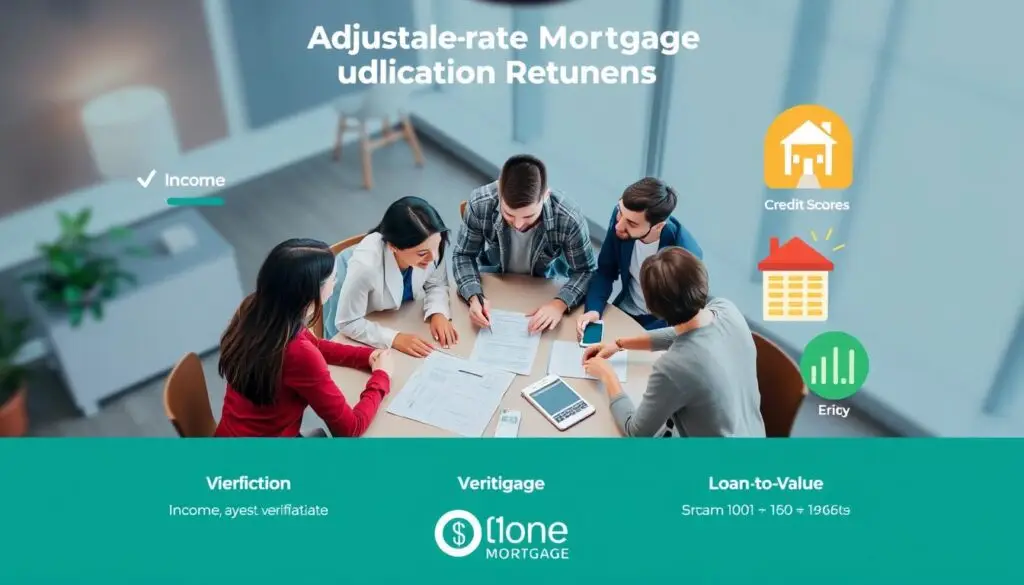At the very cornerstone of navigating homeownership finance, Adjustable-Rate Mortgages, commonly known as ARM loans, emerge as a flexible option for many aspiring homeowners. By virtue of their evolving interest rates, ARMs undeniably require a nuanced understanding. We’ll dissect the essentials of ARM loans and elucidate how they can be leveraged to your advantage, particularly with considerations like mortgage refinancing. As we venture through, remember that an ARM might initially present an attractive lower rate, but this could adjust after the initial fixed period—a crucial point to ponder when assessing the long-term financial trajectory of your home purchase.
Introduction to Adjustable-Rate Mortgages
In our journey to uncover the intricacies of Adjustable-Rate Mortgages, we must first understand their basic structure. An ARM loan kicks off with a tantalizing initial rate that often undercuts those of traditional fixed-rate mortgages. This honeymoon phase might span from a mere six months to an extended decade. Upon the culmination of this period, the mortgage metamorphoses, with the rate fluctuating in alignment with prevailing market trends. While this prospect can seem daunting, it is often a calculated move for those not foreseeing long-term ownership or those betting against incremental hikes in rates.
Key Takeaways
- Adjustable-Rate Mortgages offer an initial lower rate, creating an attractive entry point into homeownership.
- ARM loans transition from a fixed-rate period to adjustable rates, tied to market fluctuations.
- Mortgage refinancing with an ARM may be strategic, depending on market conditions and personal financial goals.
- Understanding the potential for rate and payment increases is key to managing an ARM effectively.
- Discerning when to preferable opt for an ARM demands a comprehensive analysis of interest rate trends and individual circumstances.
Introduction to Adjustable-Rate Mortgages
An adjustable-rate mortgage, often referred to as an ARM, offers a unique financial path for homeowners. These loans begin with an attractive low introductory rate, which presents an accessible entry point into home ownership. However, it’s essential to understand that this rate is not static; it’s designed to adjust over time. The frequency and magnitude of these adjustments hinge upon the prevailing economic conditions and variable mortgage rates.
When choosing an ARM, the initial lower mortgage interest rates can indeed lead to significant initial savings. Yet, the rate adjustment period also ushers in unpredictability, making it vital for borrowers to evaluate their long-term financial stability and real estate goals. Whether you aim to sell or refinance before the rate climbs, ARMs provide a strategic financial instrument to leverage brief periods of lower payments.
Yet, the pivotal concern with ARMs lies in their susceptibility to variable mortgage rates. These rates mirror the economic landscape, influenced heavily by broader financial markets and policies. Understanding this linkage is critical, as an upward shift in these rates can proportionally increase your mortgage repayments. Consequently, those considering an ARM should be prepared for potential hikes in mortgage interest rates.
To delve deeper into this topic, let’s compare the predictability of fixed-rate mortgages versus the flexibility of adjustable-rate mortgages:
- Fixed-rate mortgages: Offers long-term payment stability.
- Adjustable-rate mortgages: Initially cheaper, potentially rises depending on mortgage interest rates.
Understanding the dynamics of ARMs, particularly how variable mortgage rates influence the terms, is indispensable. It enables homeowners, especially those new to the market, to make informed, strategic decisions tailored to their financial outlooks and housing needs.
The Mechanics of ARM Loans Explained
In this section, we delve into adjustable-rate mortgages (ARMs)—a significant choice for many homeowners due to their initial lower mortgage interest rates. Understanding ARM calculations and how they function over the term of the loan can empower borrowers with the knowledge to make well-informed decisions.
Comparing Fixed-Rate and Adjustable-Rate Mortgages
Fixed-rate mortgages provide stability through consistent monthly payments and interest rates over the life of the loan. Conversely, ARMs offer an appealing low initial rate, known as a “teaser rate,” which makes them an attractive option for certain buyers. However, these rates adjust over time, influenced by the economic index to which they are tied.
Understanding the Initial Rate Period of ARMs
The initial rate period of an ARM typically ranges from five to ten years, during which the interest rate remains unchanged. This phase can be particularly advantageous for homeowners who plan to sell their property before the end of this period. During the initial rate period, homeowners can enjoy lower monthly payments or direct additional funds towards the principal of the loan.
Navigating Interest Rate Adjustments
As the initial period concludes, the ARM interest rates adjust based on a specific benchmark index plus a set margin. These adjustments occur periodically throughout the remainder of the loan term. To protect borrowers from extreme fluctuations in payments, ARMs feature payment caps. These caps limit the amount the interest rate can increase or decrease during adjustment periods and over the life of the loan.
Interest rate adjustments are a crucial element in ARM calculations, as they directly impact monthly payments and can significantly alter borrowers’ financial planning over time.
Different Types of Adjustable-Rate Mortgages
Adjustable-Rate Mortgages (ARMs) present a variety of configurations catering to diverse financial plans and risk appetites. We will explore the popular hybrid ARMs and delve into the variations and specifics of ARM loans to equip potential homeowners with essential information.
Hybrid ARMs: Combining Fixed and Variable Rates
Hybrid ARMs, such as the commonly known 5/1 ARM, blend a stable, fixed interest rate period with subsequent variable rates. Initially, borrowers benefit from predictable payments facilitating easier budgeting and financial planning. This structure is particularly advantageous for those anticipating future income growth or planning to sell before rates adjust.
The Specifics and Variations of ARM Loans
ARM loans are structured in various manners to accommodate short-term and long-term housing needs and financial strategies. Understanding the nuances of these structures, including specific adjustment periods like 3/1, 5/1, or 7/1 ARMs, is crucial for choosing a loan that aligns with your financial outlook and goals.
| Type of ARM | Fixed Term | Adjustment Frequency | Typical Use Case |
|---|---|---|---|
| 3/1 ARM | 3 years | Annual | Short-term affordability |
| 5/1 ARM | 5 years | Annual | Medium-term planning |
| 7/1 ARM | 7 years | Annual | Longer stability before adjustment |
Benefits of Choosing an Adjustable-Rate Mortgage
Opting for an adjustable-rate mortgage (ARM) brings several substantial benefits, particularly for certain financial strategies and life plans. Understanding these advantages can help you assess whether an ARM aligns with your housing and financial goals.
Initial Lower Monthly Payments and Interest Rates
One of the principal appeals of ARM loans is the prospect of initial lower monthly payments. These loans typically start with a lower interest rate compared to fixed-rate mortgages, which translates not only into lower monthly costs upfront but also offers increased budget flexibility. This crucial aspect can be a deciding factor for many homebuyers, especially those who are managing other significant financial obligations or who are in the early stages of their careers.
ARMs and Short-Term Homeownership Plans
ARMs are particularly well-suited for individuals contemplating short-term homeownership. Whether the plan involves selling the home or refinancing to a fixed-rate mortgage, the initial period of lower payments allows owners to save significantly on interest costs. This can be particularly advantageous for those who plan to move before the end of the initial fixed-rate period, typically 5 to 7 years.
Moreover, those who invest in increasing their property’s value during the low-rate period may find themselves in a highly favorable equity position when they decide to sell or refinance.
| Feature | Benefit |
|---|---|
| Lower Initial Interest Rate | Reduces monthly payment, improves cash flow |
| Flexibility | Ability to allocate funds towards investments or improvements |
| Short-Term Ownership Plan Compatibility | Financial efficiency for those not planning long-term stays |
Understanding ARM Interest Rate Caps and Their Impact
Adjustable-rate mortgages (ARMs) offer a dynamic borrowing environment, where understanding the specifics of ARM interest rate caps is critical for handling future financial scenarios. These caps are designed to protect both the lender and borrower from extreme fluctuations in interest rates, ensuring that payments remain manageable over the term of the loan.
Exploring Initial, Periodic, and Lifetime Caps
ARM interest rate caps come in three main types: initial, periodic, and lifetime. The initial cap controls how much the interest rate can increase the first time it adjusts after the fixed-rate period ends. This can greatly affect your payment caps and overall financial planning. Periodic caps limit the rate increase from one adjustment period to the next, providing an essential safeguard against sudden spikes in interest rates. Lastly, the lifetime cap sets a maximum limit on the interest rate increase over the life of the loan, protecting borrowers against extreme market fluctuations.
Calculating Your Risk with Potential Rate Increases
Calculating potential rate increases under different scenarios helps in understanding the financial impacts of ARM interest rate caps. Here, payment caps play a crucial role. Forecasting these adjustments based on current market trends and economic predictions can help borrowers manage risk and decide whether an ARM is a viable option considering their long-term financial goals.
| Cap Type | Features | Impact on Payments |
|---|---|---|
| Initial Cap | Limits first adjustment post fixed-rate period | Prevents large initial increase |
| Periodic Cap | Limits increase from one adjustment to the next | Stabilizes payment changes over time |
| Lifetime Cap | Maximum rate increase over the loan’s life | Sets absolute limit on payment increases |
In summary, ARM interest rate caps are integral to managing both expectations and budgeting for future housing costs. Understanding these caps ensures that you maintain a satisfactory balance between handling potential rises in interest rates and fulfilling your homeownership aspirations within a stable financial framework.
Pinpointing the Right Time to Opt for an ARM
Choosing the optimal moment to secure an Adjustable-Rate Mortgage (ARM) hinges on a thorough analysis of both the prevailing mortgage interest rates and broader market conditions. This decision must align with one’s personal and financial long-term plans, offering a strategic benefit under the right circumstances.
Evaluating Market Conditions and Your Future Plans
When we assess the market conditions, a pivotal aspect to consider is the trajectory of mortgage interest rates. If there is an anticipated decrease in rates, opting for an ARM might make more financial sense. This scenario is especially true for those who may not plan to stay in their homes for an extended period. Understanding and monitoring these trends are crucial to securing a mortgage that aligns optimally with personal financial projections and real estate ambitions.
When ARMs Make Financial Sense
In certain financial environments, selecting an ARM can be particularly advantageous. For example, when interest rates are relatively high, locking in an ARM with a lower initial rate that may decrease over time could result in significant savings compared to fixed-rate alternatives. This strategy is beneficial for individuals foreseeing a change in their residence or financial situation before the end of the initial fixed-rate period of the ARM.
Furthermore, for those whose credit profiles and financial circumstances make them eligible for favorable ARM terms, the potential initial lower payments provide an opportunity to allocate funds to other investments or spending needs, enhancing overall financial flexibility during the early years of the mortgage.

- Monitor ongoing economic indicators and adjust your mortgage strategy accordingly.
- Consider your long-term housing needs and financial goals when choosing between an ARM and a fixed-rate mortgage.
- Reevaluate your mortgage choice at the end of the ARM’s initial fixed period to optimize your financial benefits.
Ultimately, while ‘8’ does not dictate a specific action, it symbolically reminds us to continually evaluate and adjust our mortgage choices as part of a broader financial strategy tailored to shifting market conditions and personal circumstances.
When to Consider Refinancing From an ARM to a Fixed-Rate Mortgage
Deciding when to transition from an adjustable-rate mortgage (ARM) to a fixed-rate mortgage involves several factors. If you’re nearing the end of your ARM’s initial fixed period, it may be time to consider ARM refinancing. This strategic decision can anchor your future financial plans on more stable ground, especially when facing fluctuating interest rates.
Refinancing to a fixed-rate mortgage not only helps manage unexpected rate increases but also ensures consistent monthly mortgage payments. For homeowners planning to stay in their homes long-term, securing a fixed-rate mortgage means predictability in budgeting and financial planning.
- Safety against rising interest rates, providing peace of mind and financial predictability.
- Locking in a lower rate before ARM adjusts can save on future payment hikes.
- Long-term savings by avoiding potentially higher future rates.
However, it’s crucial to evaluate the cost-effectiveness of ARM refinancing, considering current mortgage rates and potential refinancing fees. Here are key pointers:
| Consideration | Benefit |
|---|---|
| Stability of monthly payments | Shield against the variability of ARM |
| Long-term financial planning | More predictable mortgage expense forecasting |
By understanding the dynamics between your current ARM conditions and the advantages of a fixed-rate mortgage, you can make a well-informed decision on refinancing. Keep these factors in mind to navigate your mortgage refinancing journey effectively.
The Financial Risks and Considerations of ARMs
Adjustable-Rate Mortgages (ARMs) present specific financial risks that deserve careful consideration, especially for those balancing budget constraints and long-term financing goals. In this section, we’ll delve into the complexities and volatility associated with ARM loans, highlighting what potential borrowers need to consider.
Preparing for Variable Mortgage Rates and Payments
One of the core challenges of ARM loans is their inherent unpredictability. As interest rates fluctuate, so too do your monthly mortgage payments, which can significantly impact your financial planning. Here’s a closer look:
- Mortgage Payment Variability: Payments can increase or decrease based on changes in interest rates, which are tied to a financial index that reflects wider economic conditions.
- Assessing Financial Flexibility: It’s vital to evaluate your budgeting flexibility to accommodate potential increases in payments over the lifespan of the mortgage.
Consequences of Rising Interest Rates on Budgeting
Interest rate volatility can pose significant risks to financial stability. Rising interest rates can lead to higher monthly payments that might not align with original budgeting plans tailored to a consistent repayment structure.
- Interest Rate Caps: While these caps limit how much your interest rate can increase in a single adjustment period or over the life of the loan, they don’t eliminate the risk of rising payments.
- Market Watch: Staying informed about market trends and rate projections can aid in anticipating changes that might affect your ARM and financial situation.
In essence, while ARM loans can offer attractive initial rates and the potential for reduced costs in a favorable economic climate, the associated financial risks, underscored by rate variability and its implications on budgeting, demand thorough evaluation and preparation.
Qualifying for an Adjustable-Rate Mortgage
To secure an adjustable-rate mortgage (ARM), potential borrowers must meet specific criteria set by lenders, which heavily revolves around credit scores and down payments. A solid understanding of these prerequisites ensures you are well-prepared when applying for an ARM. Successful ARM qualification offers significant advantages, including potentially lower interest rates initially, which is crucial given the interest rate variability these loans can exhibit.
Credit Scores and Down Payments for ARMs
Your credit score is instrumental in not just qualifying for an ARM but also in determining the terms you receive. Typically, higher credit scores can lead to more favorable interest rates, which is vital for managing payments as rates fluctuate. Moreover, most lenders have specific down payment requirements for ARMs, which affects both your immediate financial commitment and your equity in the property.
Understanding Lender’s Criteria for ARM Approval
Lenders evaluate several facets of your financial profile before granting an ARM to ensure that you can manage your loan, especially when rates increase. This assessment includes your income stability, existing debts, and overall financial health. Understanding these criteria can significantly influence your application’s success and your ability to handle the loan over its term.
| Factor | Importance for ARM Approval | Impact on Loan Terms |
|---|---|---|
| Credit Scores | High | Dictates interest rate and loan flexibility |
| Down Payment | Medium | Affects initial loan balance and home equity |
| Income Stability | High | Ensures ability to handle future rate increases |

The journey to obtaining an ARM involves careful consideration of one’s financial position and the market environment. If prepared adequately, borrowers can benefit from the flexibility and potential savings offered by adjustable-rate mortgages, particularly in periods where the interest rates might be more favorable than fixed-rate alternatives. Striving for an informed approach will bear fruit in achieving successful ARM qualification and sustained homeownership.
Calculations and Examples of ARM Payments
Understanding ARM payments requires a deep dive into how benchmark indexes influence rate adjustments over time. We use certain key benchmarks to illustrate just how ARM rate adjustments work and affect your monthly payments.
Benchmark Indexes Used in ARM Rate Adjustments
ARM rates are typically adjusted based on specific benchmark indexes, which serve as the guiding metrics for rate fluctuations. Common indexes include LIBOR and SOFR, which reflect broader economic conditions influencing interest rates. For instance, when the benchmark index rises, ARM interest rates, and subsequently, the monthly payments, also increase according to the 12-month average of these indexes.
Real-world Scenarios of Monthly Payment Fluctuations
Let’s consider a practical scenario: if you have an ARM loan starting at a 6.65% interest rate based on an initial principal of $350,000, let’s explore the potential financial impact over the life of the loan with adjustments in the benchmark index.
| Year | Expected Index Increase (%) | New Interest Rate (%) | Monthly Payment ($) | Total Interest Paid ($) |
|---|---|---|---|---|
| 1 | 0.00 | 6.65 | 2,246.88 | 2,692.64 |
| 5 | 0.25 | 6.90 | 2,356.75 | 16,141.00 |
| 10 | 0.75 | 7.40 | 2,618.89 | 56,866.80 |
| 15 | 1.25 | 7.90 | 3,048.55 | 120,932.65 |
| 30 | Total | Average | Varies | 618,125 |
The intricacies of ARM rate adjustments reveal the importance of understanding how benchmark indexes, such as LIBOR and SOFR, play a crucial role. They do not just dictate changes in the rate but also significantly impact the overall cost of the loan in terms of total interest paid over time.
Conclusion
In navigating the complex landscape of home financing, Adjustable-Rate Mortgages (ARMs) stand out as a mortgage option that marries flexibility with potential cost savings. This tour through the intricacies of ARMs has illuminated the numerous facets of these loans, from their initial lower payments to the eventual adjustments that can change the game for homeowners. As we’ve traversed topics like ARM loan types, the significance of rate caps, and strategic financial planning, the importance of thorough knowledge and calculated risks in the realm of mortgages becomes evident.
Our exploration confirms that ARMs can be a fitting piece of the financial planning puzzle when conditions—personal and market-related—are right. The initial savings offered by these mortgages may be attractive, but they carry the weight of uncertainty in the long term, putting a spotlight on the essential role of forecasting and readiness for change. As we encourage homeowners to ponder their mortgage options, we also prioritize their empowerment with the necessary information and expertise to navigate those decisions comfortably.
Ultimately, the decision to opt for an Adjustable-Rate Mortgage hinges on individual financial situations, market predictions, and long-term property goals. We advocate for a personalized approach, taking stock of one’s financial landscape and seeking out ample guidance to ascertain whether an ARM could unlock the doors to a favorable financial future. With the right strategy and a level head during market ebbs and flows, an ARM could be more than just a mortgage option—it could be the cornerstone of a savvy homeowner’s financial plan.







